This is the second article in the IBS and Yoga Series “It’s Your Body!” where we help you explore ways of learning to listen to your body. You can find the introduction here. And all of the articles in the series here. And be sure to read our interview with Kiera.
Where to Begin?
For this series, I will generally use the language and lens of yoga to explain postures and sequences that may benefit the abdominal region (something everyone can benefit from, not just those with IBS!), and only refer to other practices as feels helpful. As with different systems of defining the balancing energies that make us up, different somatic practices often use similar techniques or movement combinations, but with a slightly different focus, intention, or means of explanation.
The current popularity of yoga gives us a shared language that may feel more accessible than other modalities. I believe, however, that there is any number of deeply profound ways to explain the integration of body, mind, soul, time, space, etc.
Feeling Silly? You Are Not Alone.
When beginning to develop a daily practice, one thing that often waylays the process is a lack of confidence in your own knowledge, which sometimes expresses itself as embarrassment, feeling silly, or not knowing what to do next. In class, we might believe ourselves to be in the hands of an expert, and that we are not qualified to enter these practices alone.
Most beginning movers that I’ve worked with will even say, “I feel good in class, or in a lesson, but at home, I never know if I’m doing it right, so I sort of just don’t do it.” This makes sense! We are frequently warned about an injury in movement class, and the sequences are often so long and complex, that establishing your own daily practice may feel totally daunting and unrealistic.
So — Start Slowly, Start Simply but Start.
Give yourself a bit of time during the day, and space in your house. It doesn’t take a lot of space! But it certainly helps to have a clean floor, and a mat (though some of these things can be done on a bed, or outside if you feel comfortable there). You may find other props to be helpful, but they are definitely not necessary to make a practice.
Use Your Senses – They Are Great for Gleaning Information.
Look at your body.
Look at your arms, hands, fingers. Look at your legs and feet and knees, your stomach, and your chest. Observe your body when you move it around, look at the way your legs bend at the knee and your torso bends at the waist. Observe the direction your feet point when you walk, your knees, your hips.
Feel your body.
It’s your body! Get to know how it feels! Touch your legs with your hands, touch your arms with your feet. Touch your face, your lower back, your belly. Push on things, pull on things, twist them and warm them up, jump around, shake.
Just doing this every day for 5 minutes would give you tremendous insight into your state of being over time! Go through the senses, and get to know your body (also a great way to increase the sensitivity of your senses). Is there pain anywhere in your body? Is there tightness? Does doing this make you uncomfortable? Just let yourself gather information; write it down if you like, draw a picture, or just take it all in. (shame, non-judgment)
Just do this much. When you feel satisfied, continue forth!
Easy Sequence for Easing the Belly
Until you and your body are speaking the same language, these exercises might just feel like shapes that you find yourself in, they might feel like nothing. That’s ok, but be honest with yourself about where you are, maybe step back into learning about your body through your own gentle, natural movements, and observing them with your senses. Over time, it will change.
Balance Is A Moving Target
We noted above that balance is a moving target. A yoga posture holds the same principle. It is actually not a shape or a rigid structure, you can’t take a picture of a posture. It is a dynamic suggestion to the body. This is true across modalities. Twist, extend, rotate, breathe, sink, pull, release, soften, peck. Keep this in mind! There is no end goal, no picture-perfect posture, it is constant, albeit subtle, change.
Take Note: It is important to do any body practice on a relatively empty stomach (2-3 hours after eating), especially when focusing on the abdominal region. Digestion occurs best when the body is upright (heart above the stomach), and at rest.
Please note that this is not intended as medical advice. You should always check with your doctor or RDN before engaging in any activities.
Let’s Begin!
Start with laying down on your back. Let your spine rest in its natural curve, without forcing the lumbar spine down, or arching the chest. Breathe here.
Draw your left leg up and hold onto the knee, draw this bent leg into the chest.
Bring your right leg up to join it. Hold on to your knees and breathe. Breathe into your belly, feeling the pressure of your thighs against your lower abdomen as you breathe. Check in with your spine, where does it touch the floor? How is it different from when your legs were on the ground? Is your tongue relaxed? Are your teeth clenched? What unnecessary effort are you putting into this action? Let it go.
When this feels comfortable, play around with gently circling your knees. Feel the pressure change in your lumbar spine (lower back). it ought to feel really good! If it doesn’t, ease off.
Slowly drop both knees over to one side, and rest there, observing the goings on in your abdomen. Is your belly making noise? Is your lower back complaining? Try the other side. Go even more slowly.
While on your back, bring your knees back to center and extend them straight out, back to the floor. Notice if your body feels any different. Notice the left side and the right side. Is the curve of your spine the same? How does your belly feel?
Roll onto your belly, come onto hands and knees in a tabletop position, bring your toes together, knees apart, and press yourself back so that your belly is resting on your thighs, and your forehead is on the ground. Rest. This is the basic shape of child’s pose, a resting posture that is wonderful for digestive support. Breathe into your belly, play with movement from this position. Be gentle here, be soft.
That’s all you have to do today – bring your legs into your chest, twist, and rest in child’s pose.
This could take 5 minutes, 10 minutes, you could explore just this for an hour, a week. The information available to you is infinite because it is always changing. Stay tuned in! It’s your experience. If you are bored, notice that. If you are in pain, notice that. If you repeat the action tomorrow, notice that.
Food For Thought
As so beautifully defined in the introduction to my copy of the Upanishads, “The self-training for the vision of the unity of Atman [the ‘soul’ within] and Brahman [the ultimate reality] is called Yoga.” This is a practice of observation and integration, increasingly perceptive, increasingly patient, simultaneously infinite in any direction, but always towards Love and Truth.
As so sweetly contemplated by William Blake:
To see a World in a grain of sand
And a Heaven in a wild flower,
Hold Infinity in the palm of your hand,
And Eternity in an hour.


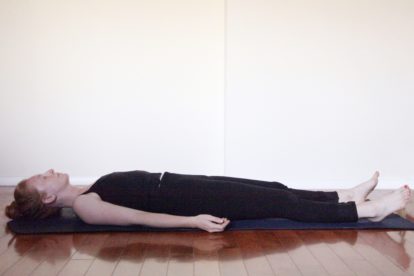
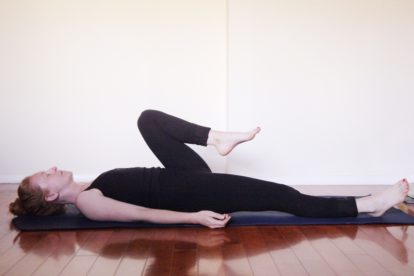
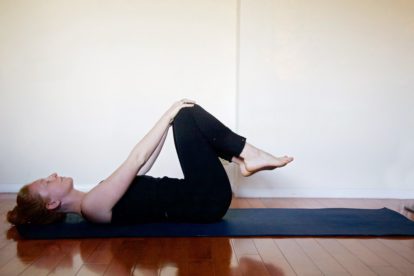
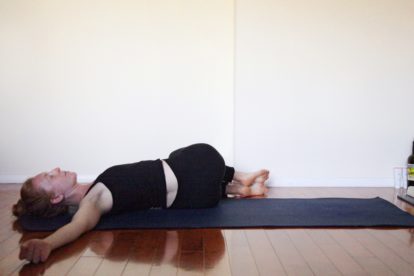
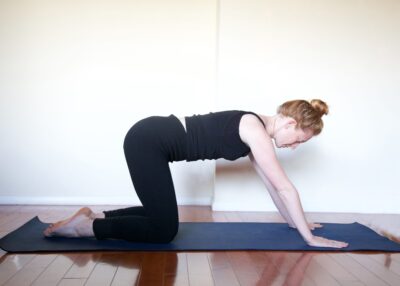
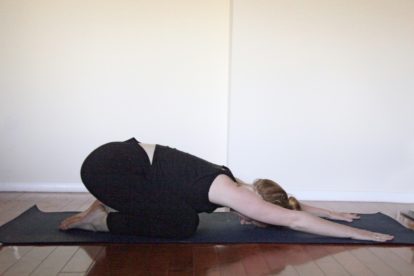
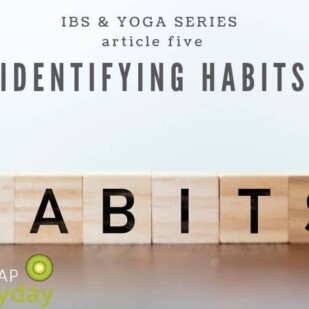
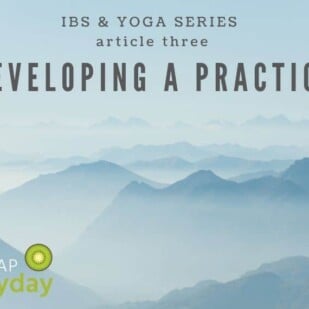






Thank you for the yoga and IBS series. I have read and followed the first two articles thus far. Wonderful, comforting, reassuring.
Lisa, thank you for taking the time to write, and we are so happy that this series has been helpful! We are editing an article right now on “Intuitive Eating” that might be up your alley. Stay tuned!